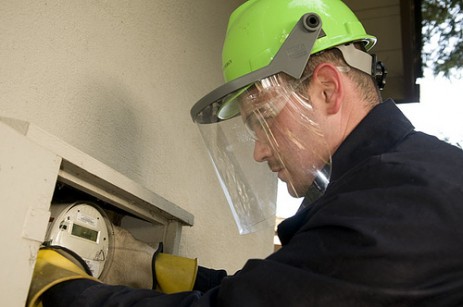 Smart meters let you track real-time energy use.Photo: PG&E EnergyNo one said transforming the century-old power system into a state of-the-art digital smart grid was going to be easy. But California already is getting bogged down in a growing fight over installing smart utility meters in homes.
Smart meters let you track real-time energy use.Photo: PG&E EnergyNo one said transforming the century-old power system into a state of-the-art digital smart grid was going to be easy. But California already is getting bogged down in a growing fight over installing smart utility meters in homes.
The wireless devices are a linchpin in building the smart grid as they allow the two-way, real-time transfer of data about a home’s power use. Utilities need that information to balance supply and demand on a power grid that will be increasingly supplied with intermittent sources of renewable energy while facing new demands from electric cars.
For homeowners, smart meters and an expected proliferation of smart refrigerators, dishwashers, and other appliances will help them keep a lid on rising electricity costs while making better use of rooftop solar panels.
But from the get-go, smart meters have raised a ruckus in California. First, residents in the state’s hot Central Valley complained that their utility bills spiked after the meters were installed last year.
Then in the San Francisco Bay Area, a small but vocal contingent has been arguing that smart meter antennas are a potential health threat. Never mind that every other person here seems to carry an iPhone, and many, if not most, homes in this tech-centric region boast wireless Internet routers that continuously transmit electromagnetic frequencies through the ether.
At first smart meters appeared to be a fringe issue — at the Fourth of July parade in the Marin County hippie beach enclave of Bolinas, I saw people holding up ban-the-smart-meter banners. But last week, I spotted similar homemade signs at the Berkeley Farmers’ Market. Meanwhile, the Marin town of Fairfax has moved to ban smart meter installations; Santa Cruz County is considering doing the same.
Lost in all the hullabaloo is what a smart meter can do for managing your home’s carbon footprint. There are all kinds of gadgets and services coming down the pike that will let you control your electricity use from your phone and pinpoint the power hogs in your home. But even the most basic information provided by a smart meter is a big leap from a once-a-month bill.
My utility, PG&E, installed a smart meter at my house some months ago but just the other week began to let me monitor my electricity use on its website. If you want to geek out, you can really get granular by charting your power use hour-by-hour, pinpointing spikes and seeing how your lifestyle affects your energy consumption.
This morning, for instance, I learned that 21 days into the current billing cycle I’ve used $11 worth of electricity and that my projected total bill is between $15 and $20. My daily electricity use peaks around 6 a.m. and 8 p.m. and I’m using slightly fewer kilowatts than this time last year. I also set up an email alert to be sent if my electricity consumption kicks me into a more expensive rate tier.
And in the keeping down-with-the-Jones department, I learned that my energy use puts me at the very low end of the Berkeley spectrum.
All this provides valuable insight for the building of the green grid. But as with other efforts to transition to a renewable energy economy, overcoming political obstacles to the smart grid may be just as crucial as any technological triumph.


